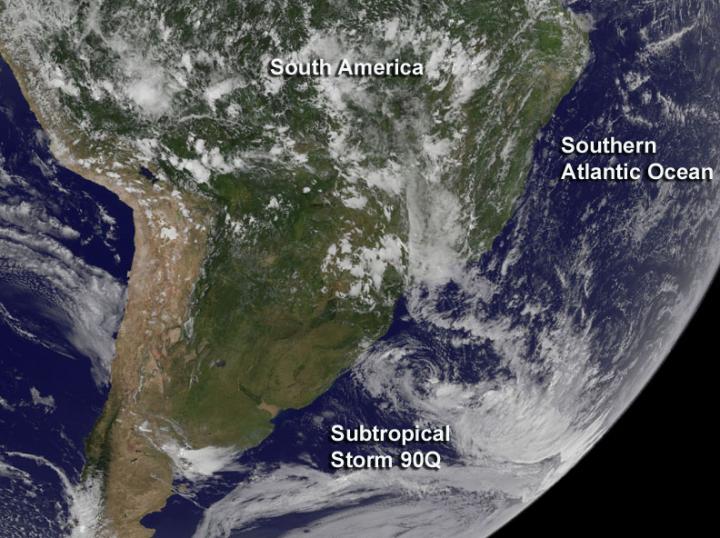Satellite sees rare subtropical storm 90Q in southern Atlantic

This GOES-East "full disk" view of the Atlantic Ocean from 17:45 UTC (1:45 p.m. EDT) on March 12 shows newborn sub-tropical cyclone 90Q. Credit: NASA/NOAA GOES Project
NOAA's GOES-East satellite provided imagery of the Atlantic that showed Subtropical Cyclone 90Q off the southeastern coast of Brazil at 17:45 UTC (1:45 p.m. EDT).
The system appeared to have fragmented banding of thunderstorms around the low-level center.
The image was created by NASA/NOAA's GOES Project at NASA's Goddard Space Flight Center in Greenbelt, Maryland.
At 1200 UTC (8 a.m. EDT) on March 12, the Brazilian Navy Hydrographic Centre (BNHC) noted that Sub-tropical storm 90Q was located near 32 degrees south latitude and 44 west longitude.
90Q's minimum central pressure was estimated near 1006 millibars. Maximum sustained winds were near 45 knots (51.7 mph/83.3 kph) and it was moving to the south-southeast at 5 knots (5.7 mph/9.2 kph).
For more information, visit the BNHC website at: http://www.
Media Contact
All latest news from the category: Earth Sciences
Earth Sciences (also referred to as Geosciences), which deals with basic issues surrounding our planet, plays a vital role in the area of energy and raw materials supply.
Earth Sciences comprises subjects such as geology, geography, geological informatics, paleontology, mineralogy, petrography, crystallography, geophysics, geodesy, glaciology, cartography, photogrammetry, meteorology and seismology, early-warning systems, earthquake research and polar research.
Newest articles

Silicon Carbide Innovation Alliance to drive industrial-scale semiconductor work
Known for its ability to withstand extreme environments and high voltages, silicon carbide (SiC) is a semiconducting material made up of silicon and carbon atoms arranged into crystals that is…

New SPECT/CT technique shows impressive biomarker identification
…offers increased access for prostate cancer patients. A novel SPECT/CT acquisition method can accurately detect radiopharmaceutical biodistribution in a convenient manner for prostate cancer patients, opening the door for more…

How 3D printers can give robots a soft touch
Soft skin coverings and touch sensors have emerged as a promising feature for robots that are both safer and more intuitive for human interaction, but they are expensive and difficult…




















